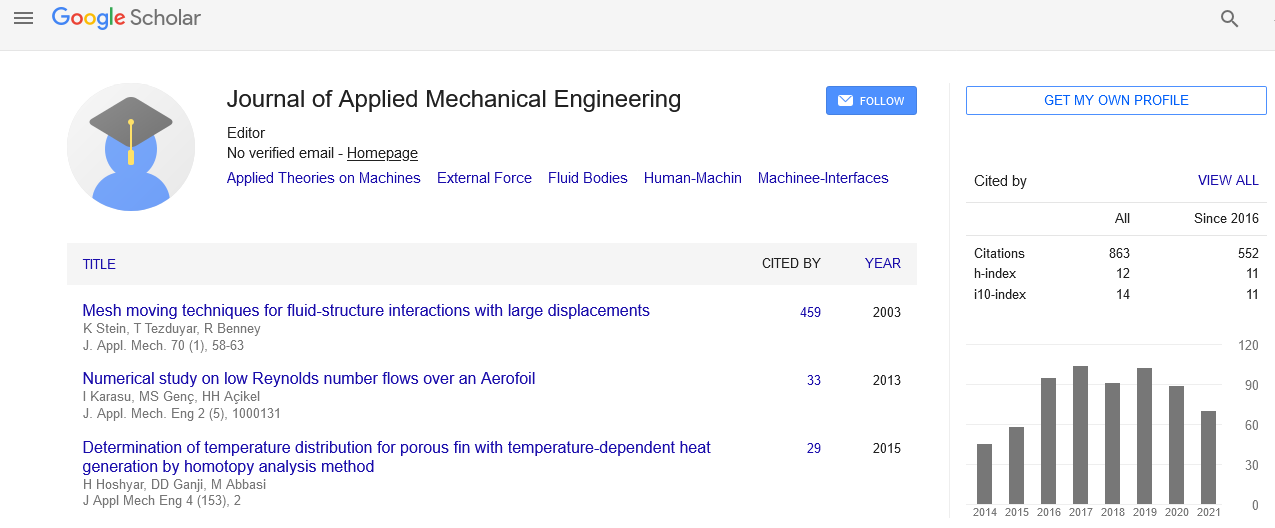Indexed In
- Genamics JournalSeek
- JournalTOCs
- CiteFactor
- RefSeek
- Hamdard University
- EBSCO A-Z
- OCLC- WorldCat
- Publons
- Google Scholar
Useful Links
Share This Page
Journal Flyer

Open Access Journals
- Agri and Aquaculture
- Biochemistry
- Bioinformatics & Systems Biology
- Business & Management
- Chemistry
- Clinical Sciences
- Engineering
- Food & Nutrition
- General Science
- Genetics & Molecular Biology
- Immunology & Microbiology
- Medical Sciences
- Neuroscience & Psychology
- Nursing & Health Care
- Pharmaceutical Sciences
Commentary - (2023) Volume 12, Issue 1
Analyzations of Non Fourier Heat Conduction Models for Thermo mechanical Equipment
Kalptero Clin*Received: 02-Jan-2023, Manuscript No. JAME-23-19987; Editor assigned: 04-Jan-2023, Pre QC No. JAME-23-19987 (PQ); Reviewed: 18-Jan-2023, QC No. JAME-23-19987; Revised: 23-Jan-2023, Manuscript No. JAME-23-19987 (R); Published: 03-Feb-2023, DOI: 10.35248/2168-9873.23.12.458
Description
In order to discuss on coupled dynamical thermomechanical theory we need to describe average properties of material without reference to the detailed atomic structure. The study that takes account of the existence of gaps is called microscopic study. On the other hand, the study that ignores the gaps and treats a physical object as a continuous distribution of matter is called macroscopic study. A continuum is a medium with a geometric configuration in the Euclidean space which exhibits continuous macroscopic properties. The neighboring molecules remain neighboring under the action of any loading conditions and no geometric discontinuity may occur. A part of a continuum which is separated from the rest of the continuum is called a system. A closed system does not exchange matter with its surroundings. If a system does not interact with the surroundings, it is called an isolated system. The macroscopic characteristics of the system defined by means of statistical averaging procedures are called state variables and for a system they are the density, specific volume, specific pressure, temperature, velocity, enthalpy, entropy and internal energy.
A thermodynamic process to proceed from a given state to a final state, the functional relationship between the properties must be known. When a property of the system is expressed by a single valued mathematical relationship to a set of other system properties, the mathematical relation is called the equation of state.
There are two types of forces acting on the continuous body. They can be categorized as internal forces or external forces. Internal forces are due to interaction between the constituent particles of a continuum whereas external forces are exerted by the external agencies. Whenever there is a change in the relative position of the particle of a body, it is said that body is deformed or strained and the transformation which cause such change is called deformation. A continuum solid when exhibits elastic property, i.e., when it is subjected to external loads gets deformed and returns to its original shape and size on removal of external forces, is called elastic body.
The deformation in a continuum is mainly due to two external forces (a) Body forces and (b) Surface forces. A body force is a force that acts throughout the volume of a body. Forces due to gravity, electric fields and magnetic fields are examples of body forces. Surface force always acts on a surface and results from physical contact with another body. Surface force can be decomposed into two perpendicular components: normal forces and shear forces. A normal force acts normally over an area and a shear force acts tangentially over an area.
Conclusion
External loads are cause of internal forces. Internal forces represent the action of one part of a material on another part of the same material across an internal surface. The force per unit area set up inside the body to resist deformation is called stress. There are two types of stress, if the resisting area is perpendicular to the applied force, then such type of stresses are known as normal stress. Forces parallel to the area resisting the force cause shearing stress. All materials have a complex molecular microstructure and each molecule exerts a force on each of its neighbours. The complex interaction of countless molecular forces maintain a body in equilibrium in its unstressed state.
Citation: Clin K (2023) Analyzations of Non Fourier Heat Conduction Models for Thermo mechanical Equipment. J Appl Mech Eng. 12:458.
Copyright: © 2023 Clin K. This is an open-access article distributed under the terms of the Creative Commons Attribution License, which permits unrestricted use, distribution, and reproduction in any medium, provided the original author and source are credited.

